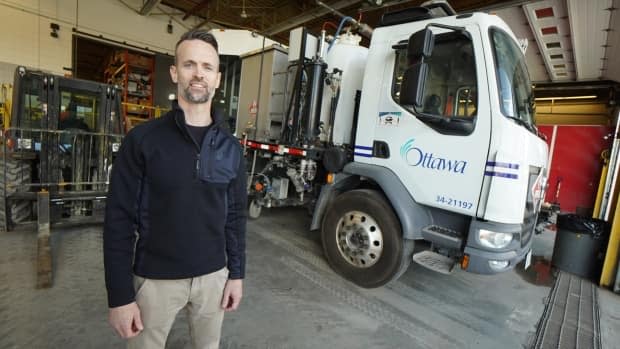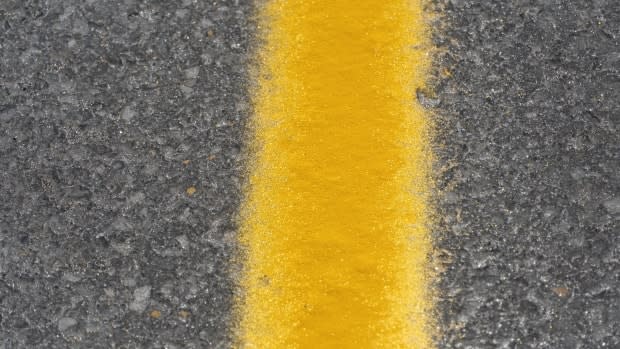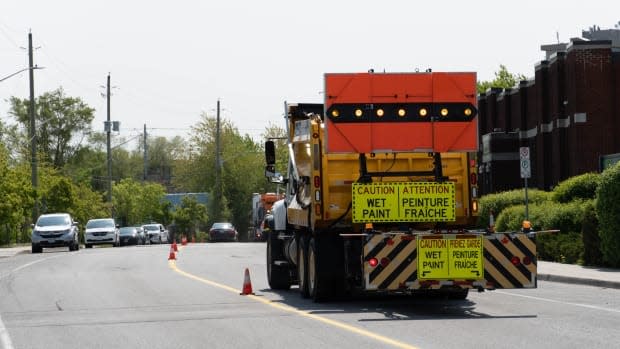City turns to fresh road-painting technology to hold the line

Springtime in Ottawa, when tulips bloom, birdsong fills the air and city crews hit the streets to repaint the lines and other markings worn nearly invisible by a winter's worth of snowplows, grit and traffic.
Now they have a new tool in their perennial struggle — a high-tech truck capable of painting lines that can last three or four times longer than before.
The city's new methyl methacrylate (MMA) paint truck is currently working overtime as crews scramble to refresh the markings at more than 6,500 intersections and countless kilometres of roadway and cycling lanes.
The $747,000 truck was acquired in 2021 and fully deployed last summer once staff had been trained to operate it.
MMA paint consists of a pigmented resin and a catalyst that typically cure within 15 minutes of application. Another layer of tiny glass beads is sprayed overtop to give the markings their reflective quality.

Jared Hebbs, the program manager in charge of signs and pavement markings within the city's traffic services branch, said while his department still uses acetone and water-based paints, MMA is quickly becoming the preferred option.
"We're thinking this is going to be a good product for us going forward," Hebbs told CBC earlier this month. "Now that we're rolling we're noticing great benefits to it."
The MMA truck is crewed by up to three: a driver in front and one or two painters/operators in the rear, depending on the job at hand.

Its one drawback is that applying the paint requires warmer temperatures, so while the city's other road-painting truck usually gets rolling in early May and keeps working until November, the MMA truck tends to run from June until September.
But while it might have a slightly shorter season, the lines it leaves behind will last longer before they need to be repainted, Hebbs said. In the long run, that should reduce the amount of time road crews spend each spring repainting faded markings.
It may be too soon to say whether residents have noticed an improvement, however.

About a decade ago, when the federal government ordered municipalities to switch to low-volatile organic compound (VOC) paint — environmentally safer, but far less durable — complaints from the public about road markings doubled, from fewer than 600 calls a year to more than 1,200.
The complaints levelled off again around 2017 before dropping significantly a couple years later. According to Hebbs, the COVID-19 pandemic was likely a factor because there were fewer motorists, cyclists and pedestrians moving around town.
So was a 2019 council decision to enhance the city's road painting efforts by prioritizing high-volume pedestrian crossings and other key areas.

Hebbs said the move to MMA paint should help keep complaints in check.
"We continue to implement the decision to utilize durable pavement marking products for arterial roads with the goal of reducing complaints by 80 per cent overall," he explained.
Other more durable road-marking methods include thermoplastics, which are pieced together "like a jigsaw puzzle" and sealed to the pavement with a blowtorch, Hebbs said. They're used to mark the bright green boxes in bike lanes, for example.

The city's road-painting operation employs 35 people and has a budget of $5.2 million this year alone.
In addition to the two trucks, they use 10 smaller units — picture a riding mower that paints lines instead of cutting grass — working in 10-hour shifts, often overnight to avoid disrupting traffic. (Some of those smaller units are also equipped to apply MMA paint.)
Still, it can take them a long time to reach every corner of a city with such a vast geographical footprint as Ottawa. From May to November, they use about half a million litres of paint to cover about four million metres of road surface.
"Be patient, it's a large area," Hebbs advised residents. "We work tirelessly to make sure it all happens."



